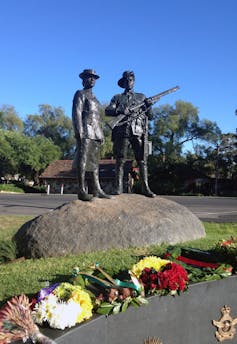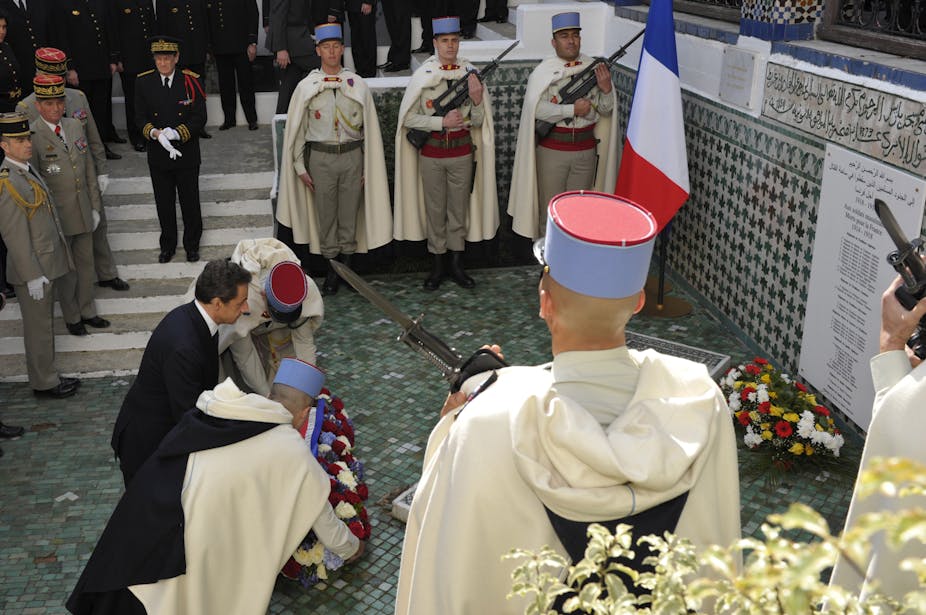In vogue among the political left during the events in Paris in May 1968, the French term récupération refers to the danger of “the Establishment”, be it the government or a political party, seizing on an issue and opportunistically turning it to its own ends and advantage. An illustration can be found in the recent “recuperation” of the service of troops from France’s colonies who fought in the two world wars.
In Australia too, the “great silence” concerning black diggers has undergone a dramatic reversal.
Soldiers from France’s colonies
For a long time, soldiers from its colonies were relatively sparsely commemorated in France, although many monuments were raised in the colonies themselves. In recent years, however, their service has been the object of sustained presidential attention.
In 2006, then-president Jacques Chirac unveiled a memorial to the Muslim soldiers who died at the battle of Verdun at Douaumont. In 2012, Chirac’s successor, Nicolas Sarkozy, inaugurated a temporary plaque at the Great Mosque in Paris dedicated to the memory of Muslim soldiers who were killed in the Great War. In February 2014, current president François Hollande dedicated two permanent memorials to those who died in both world wars.
These commemorative gestures have drawn both considerable comment and criticism. Critics have asked if it is in accordance with the principles of the French Republic, which relegates confessional allegiance to the private sphere, to identify soldiers in this way – that is, through their religion.
Critics have also been quick to point out the timing of these gestures, coinciding with the run-up to elections or at a time of unpopularity due to measures that seem to stigmatise Muslims.
The presidents’ speeches make clear that they hope this recognition of the “sacrifice of all the Muslim soldiers who died for France” (in Sarkozy’s words) will contribute to the reconciliation of the second and third generations of Maghrebian immigrants (the “Beurs”) and their integration in French society. This is an illustration of the well-established trope in the social sciences that commemoration is far more about the present than the past.
Indigenous Australian soldiders
The conditions in which the French colonial troops served and those of the Aboriginal soldiers in Australia were different in many ways. Australia’s Aboriginals were formally excluded from military service, but nevertheless enlisted in the regular army in their hundreds for the First World War and in their thousands for the Second World War.
In France, however, hundreds of thousands of troops from the colonies were raised and organised into separate fighting units.
But in the racially and socially discriminatory context of the post-war eras, both groups found that their rights as veterans were ignored and their service forgotten – until recently.
In the last 15 years or so, the official institutions that for so long overlooked Indigenous service have begun to promote their memory. The Australian War Memorial has developed an education program for schoolchildren, held several major exhibitions including Too Dark for the Light Horse, which toured in 2000-01, and has many projects to commemorate black diggers over the Anzac Centenary period.

The monuments dedicated to Aboriginal and Torres Strait Islander soldiers have become increasingly ambitious and prominent. The latest, dedicated in Adelaide in November 2013, lays claim to being the first national memorial. Another is to be built in central Sydney’s Hyde Park for 2015.
The Returned and Services League (RSL) has partnered with city authorities and the Department of Veterans Affairs (its “Wartime Legends” initiative) since 2007 to hold annual commemorations during Reconciliation Week.
The dangers of recuperation
So who could object to such recognition after decades of neglect? And yet what are the dangers of recuperation of the service of black diggers in the interests of a kind of “soft reconciliation” that downplays the reality of Indigenous experience before during and after the war, for the vast majority of the Aboriginal population?
South Australian Liberal senator David Fawcett asserted in his Remembrance Day speech last year:
The fact that so many [Aboriginal] people served when so many barriers were put in their way is, I think, a testament to their love of country – they actually wanted to serve their people and their nation.
Here, Fawcett used Aboriginal war service to promote a pacified vision of European-Indigenous relations.
The commemoration of black diggers contributes to the adaptation and modernisation of the Anzac myth for contemporary Australia. Multicultural Australia requires a multicultural Anzac commemoration that incorporates groups who were formerly excluded, not only Aborigines but also Chinese diggers, for example. Witness the memorial to Chinese-Australian diggers in Sydney’s Chinatown and the renewed interest in “The Assassin”, Billy Sing – a renowned sniper at Gallipoli.
Such recognition allows the Chinese and Aboriginal communities to share in the narrative of nation-building based on war service. But it also leaves that narrative relatively untouched. As Celeste Liddle wrote recently, the Indigenous perspective on war should also be about challenging the mythology of war.
Rather than recuperating the black diggers and soldiers from minority communities into the “militarisation” of Australian history, let’s use their stories to cast a different perspective on war - to complicate the assumptions about why men enlisted, for example. Their stories can help complete the picture of the post-war neglect of veterans, both black and white, and inform discussion about war’s terrible impact on individuals and communities.
Read the other articles in The Conversation’s Commemorating WWI series here.

